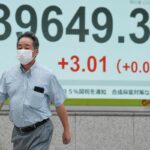
U.S. stock indexes climbed higher Friday afternoon but the benchmarks may still end with losses for the week on fears over the spread of the coronavirus delta variant, the imminent tapering of Federal Reserve bond buying, and China’s restrictions on its economy.
Friday’s recovery looked fairly broad by the afternoon, with technology stocks among the leaders in the S&P 500 and even energy catching a bid after a withering week for the sector as oil prices slumped.
How are benchmarks trading?
- The Dow Jones Industrial Average DJIA gained 229 points, or 0.6%, at 35,123.
- The S&P 500 SPX traded 0.8% higher to reach 4,439, up 33 points.
- The Nasdaq Composite Index COMP advanced 155 points, or 1.1%, to 14,697.
On Thursday, major markets ended mixed, with the S&P 500 and Nasdaq Composite registering small gains, while the small-cap Russell 2000 ended 1.2% lower.
For the week, the S&P 500 is headed for a weekly slide of 0.7%, the Dow is on track for a 1.1% weekly decline, the Nasdaq Composite is on track for a 0.9% fall, while the small-cap Russell 2000 index RUT is down 2.7% so far this week.
What’s driving markets
Buy the dip for the week looked to be the play on Friday, with investors scooping up shares of information technology XX:SP500 and turning to embattled energy XX:SP500 and financials XX:SP500, among the worst performers for the week.
“The tidal wave of liquidity is so powerful, so vast, that the buy-the-dips mentality is the dominant force right now,” said David Donabedian, chief investment officer of CIBC Private Wealth Management, in a phone interview Friday. Information technology and communications services are among the areas leading the market in Friday’s trading, he said, similar to last year when COVID-19 was “raging” and “stay-at-home stocks” topped the charts.
The energy sector is down 7% so far this week, while financials are off 2.9%, FactSet data show. Consumer staples XX:SP500 are up 0.2% for the week, healthcare XX:SP500 is up 1.8%, and utilities XX:SP500 have seen a gain of 0.6%, which are largely defensive plays. Technology, meanwhile, was erasing some of its weekly slide.
The U.S. stock market’s declines this week are “certainly not earth shattering,” said Donabedian. “It’s a very modest pullback from all-time highs.”
All week, concerns about a sharp rise in U.S. COVID cases, hospitalizations and deaths have tamped down bullishness, as the daily average of new U.S. cases over the past seven days rose to 143,827 as of Thursday, up 44% from two weeks ago and the most since Feb. 1, according to a New York Times tracker.
Donabedian told MarketWatch that he’s closely watching Covid-19 hospitalization trends in the U.S., amid some expectations that the delta-variant wave could peak in a few weeks. But “we know this virus is unpredictable,” he said.
The change in the complexion of the viral spread is causing some Fed members to rethink tapering strategies.
Researchers at Capital Economics said that delta’s spread continues to weigh on prices, particularly in the commodity complex. “Commodity prices mostly fell this week on the back of a stronger U.S. dollar as well as mounting concerns over the demand outlook,” Capital Economics economists wrote in a Friday note.
Indeed, Dallas Federal Reserve President Rob Kaplan said he may reconsider his call for the central bank to quickly start to taper its monthly buying of $120 billion in Treasury and mortgage-backed securities if it looks like the spread of the coronavirus delta variant is slowing economic growth.
“It is in all of our interest to slow the spread, and right now we’re in a negative trend,” Kaplan said in an interview with Fox Business Network on Friday. Kaplan said the delta variant has caused him to have an open mind about the path of monetary policy. He called the delta variant “the big imponderable” in the outlook.
The remarks from Kaplan, who is a “more hawkish” Fed official, may be contributing to the market’s rise Friday, according to Donabedian. Just a couple of days ago, the release of the Fed policy meeting minutes had indicated “consensus to begin tapering this year,” he said, and some investors may now see the possibility that the central bank could “adjust its thinking.”
Michael Hartnett, chief investment strategist at Bank of America, says the market is acting in a recessionary fashion.
“The key 10-year yields were barely changed as equities reversed, suggesting that the move was more about the top-down risks to growth building, specifically around the delta variant, after several weeks when the bottom-up corporate news has provided support,” said Ian Williams, a strategist at U.K. broker Peel Hunt.
The U.S. yield curve, as measured by the gap between the 5- BX:TMUBMUSD05Y TMUBMUSD05Y and 30-year BX:TMUBMUSD30Y bonds, is at its flattest in a year. Global stocks excluding U.S. technology shares are unchanged the last eight months. Emerging market stocks are negative this year. U.S. small-cap stock prices are breaking down. A range of commodity prices have fallen by double-digit percentages from highs. And the top four sectors of the S&P 500 index in the second half of the year so far are utilities, healthcare, REITs and staples.
“What we’ve been telling clients is the first half of the year was nirvana,” with above-average gains and “very low market volatility,” said Baltimore-based Donabedian of CIBC Private Wealth. “We’re in a bull market, but it’s going to be a tougher slog over the second half of the year.”
The Cboe Volatility Index VIX, often referred to by its ticker symbol VIX, a measure of implied stock market volatility, jumped in the early hours Friday, while the U.S. dollar DXY reached a fresh nine-month high. The VIX was trading 12% lower by Friday afternoon, according to FactSet data, at last check.
Which companies are in focus?
- Shares of Mudrick Capital Acquisition Corp. II MUDS were in focus Friday, after the special-purpose acquisition company, SPAC, said the merger agreement that would’ve have taken The Topps Company public has been terminated “by mutual agreement.” The stock was down about 2.5% Friday afternoon.
- Shares of Deere & Co. DE fell 2.3% after the construction, agriculture and turf care equipment maker reported fiscal third-quarter profit that more than doubled and was well above expectations, and raised its full-year net income outlook.
- Foot Locker Inc. FL shares jumped 8.5% after the athletic retailer reported second-quarter earnings that far exceeded expectations.
- LumiraDx Ltd. and SPAC CA Healthcare Acquisition Corp. said Friday the value of their merger deal to take LumiraDx public has been cut by 40%, citing “various considerations,” including recent market environment for publicly traded diagnostic companies and declines in COVID-19 testing volumes.
How are other assets faring?
- The yield on the 10-year Treasury note TMUBMUSD10Y was up around 1 basis points at 1.258%. Yields fall as bond prices rise.
- The ICE U.S. Dollar Index DXY, a measure of the currency against a basket of six major rivals, was down 0.1% and traded around a nine-month high.
- Oil futures were set for a seventh straight decline, with the U.S. benchmark CL00, down more 2% at $63.31 a barrel, headed for a 9% decline and its sharpest weekly slide in nine months. Gold futures GC00, were up 0.1% near $1,786 an ounce.
- In Europe, the Stoxx Europe 600 SXXP closed 0.3% higher, but was still down 1.5% for the week. London’s FTSE 100 UKX rose 0.4% , but saw a weekly decline of 1.8%.
- In Asia, Hong Kong’s Hang Seng HK:HSI suffered another rough session, falling 1.8%, as the index is now 19% below its February high on the continued regulatory crackdown in China. China on Friday passed a strict data privacy law that is due to take effect in November. Meanwhile, while the Shanghai Composite SHCOMP shed 1.1% and Japan’s Nikkei 225 NIK declined 1%.
—Steve Goldstein contributed to the report.








